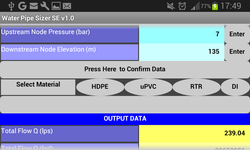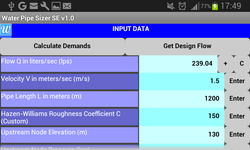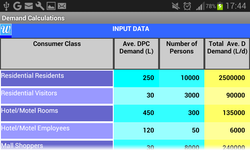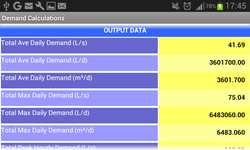 |  |  |
|---|---|---|
 |  |  |
 |  |  |
 |  |  |
 |  |  |
 |  |  |
 |  |  |
 |  |  |
 |  |  |
 |  |  |
 |  |
 |  |  |
|---|---|---|
 |  |  |
 |  |  |
 |  |  |
 |  |  |
 |  |  |
 |  |  |
 |  |  |
 |  |  |
 |  |  |
 |  |
WATER PIPE SIZER SE USER GUIDE
Important: Read carefully before using the app.
In the home screen pressing the “Calculate Demand” button will open another screen for encoding design data that includes consumer class, average daily potable water demand per consumer class and number of occupants. This feature is useful for quick sizing of water trunk lines when access to spreadsheet is not available.
The total average water demand for each consumer class is calculated automatically after encoding the relevant data. Make sure to press the corresponding textbox in the Total Ave Daily Demand column to calculate the total demand for each consumer class. When data for a particular consumer class is not required, the default value of zero in the corresponding data fields should be left unchanged. Pressing the “Press Here to Calculate Totals” button will display all calculated outputs.
To size the pipe, press the “Pipe Sizer Screen” button. In the “Flow Q in liters/sec (lps)” data field, press the “Get Flow” button to import the population based design flow from the database and consequently press the “+” button to add the data in the system. Alternatively, if the design flow in liters per second is already available for a particular pipe, the figure for design flow can be encoded manually. In the “Flow Q in liters/sec (lps)” data field, encode the design flow and press the “+” button to add the data in the system. Encode the relevant data for design flow, design velocity, length of pipe and Hazen-Williams friction loss coefficient C for the required pipe material.
Note that subsequent pressing of the “+” button will add and accumulate subsequent encoded flow data to the system flow data. In case flow data is encoded incorrectly. Pressing the “C” button will clear the system flow data. Encode the rest of the data figures if necessary and press the corresponding “+” button and finally press the “Press here to confirm data” button to confirm that all data is correct. To size the pipe, press the required pipe material button. The output will be displayed in the corresponding data fields at the right column.
Limitations:
Selection of pipe materials used in this app is limited to the typical pipe materials used in clean water infrastructure networks and does not include other metallic pipes as steel and carbon steel pipes typically used in industrial process and petrochemical industries. However, the app can still be used by process water piping designers by using applicable standard design criteria such as Hazen-Williams C and pressure loss limitations for the required metallic pipe and refer to standard catalogues for pipe size selection based on the calculated minimum internal pipe diameter output. A Google internet search screen is available in case users need to search for pipe catalogues without leaving or exiting the app.
Hydraulic grade line (HGL), node pressure, and head gain or head loss due to node elevation differences not included in the lite version of this app are now considered in the calculations. Elevations for upstream node and downstream node shall be encoded by the user to calculate the pressure in the downstream node and the corresponding HGL. Minor pressure loss such as fitting loss is not considered in the calculations as it is negligible for one pipe analysis and is best applied when building detailed network hydraulic models.



